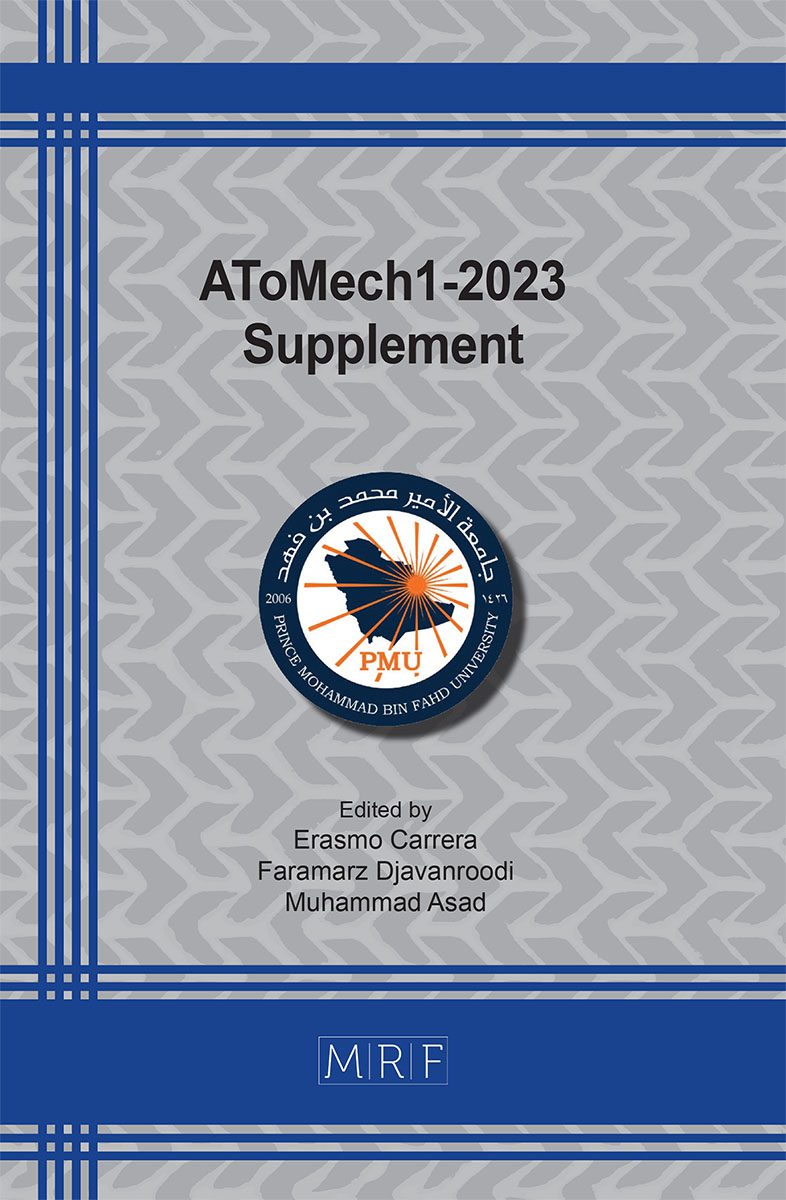Statistical analysis of fatigue behavior in additively manufactured steels
Ali Alhajeri, Mosa Almutahhar, Jafar Albinmousa, Usman Ali
download PDFAbstract. The effect of building orientations, sample conditions, and loading ratio (R-value) are important factors in terms of fatigue behavior. The aim of this paper is to investigate the factors that affect the fatigue behavior in additively manufactured laser powder-bed fusion (LPBF) 316L stainless steel. A statistical analysis was performed to point the significant and insignificant factors with different building orientations, samples conditions, and R-value. This statistical analysis provides the most significant factors to be considered for fatigue behavior of 316L stainless steel additive manufacturing.
Keywords
Stainless Steel 316L, LBPF, Orientation, Condition, R-Value, Fatigue Behavior
Published online 9/25/2023, 7 pages
Copyright © 2023 by the author(s)
Published under license by Materials Research Forum LLC., Millersville PA, USA
Citation: Ali Alhajeri, Mosa Almutahhar, Jafar Albinmousa, Usman Ali, Statistical analysis of fatigue behavior in additively manufactured steels, Materials Research Proceedings, Vol. 36, pp 56-62, 2023
DOI: https://doi.org/10.21741/9781644902790-6
The article was published as article 6 of the book AToMech1-2023 Supplement
![]() Content from this work may be used under the terms of the Creative Commons Attribution 3.0 license. Any further distribution of this work must maintain attribution to the author(s) and the title of the work, journal citation and DOI.
Content from this work may be used under the terms of the Creative Commons Attribution 3.0 license. Any further distribution of this work must maintain attribution to the author(s) and the title of the work, journal citation and DOI.
References
[1] E. Atzeni and A. Salmi, “Economics of additive manufacturing for end-usable metal parts,” International Journal of Advanced Manufacturing Technology, vol. 62, no. 9–12, pp. 1147–1155, Oct. 2012. https://doi.org/10.1007/s00170-011-3878-1
[2] F. Ahmed et al., “Study of powder recycling and its effect on printed parts during laser powder-bed fusion of 17-4 PH stainless steel,” J Mater Process Technol, vol. 278, Apr. 2020. https://doi.org/10.1016/j.jmatprotec.2019.116522
[3] J. Dawes, R. Bowerman, and R. Trepleton, “Introduction to the additive manufacturing powder metallurgy supply chain,” Johnson Matthey Technology Review, vol. 59, no. 3. Johnson Matthey Public Limited Company, pp. 243–256, 2015. doi: 10.1595/205651315X688686
[4] G. S. Ponticelli, R. Panciroli, S. Venettacci, F. Tagliaferri, and S. Guarino, “Experimental investigation on the fatigue behavior of laser powder bed fused 316L stainless steel,” CIRP J Manuf Sci Technol, vol. 38, pp. 787–800, Aug. 2022. https://doi.org/10.1016/j.cirpj.2022.07.007
[5] R. Shrestha, J. Simsiriwong, and N. Shamsaei, “Fatigue behavior of additive manufactured 316L stainless steel parts: Effects of layer orientation and surface roughness,” Addit Manuf, vol. 28, pp. 23–38, Aug. 2019. https://doi.org/10.1016/j.addma.2019.04.011
[6] R. Shrestha, J. Simsiriwong, N. Shamsaei, S. M. Thompson, and L. Bian, “Effect of build orientation on the fatigue behavior of stainless steel 316l manufactured via a laser-powder bed fusion process,” 2016. Accessed: Jan. 01, 2016. [Online]. Available: https://hdl.handle.net/2152/89615
[7] R. Shrestha, J. Simsiriwong, and N. Shamsaei, “Fatigue behavior of additive manufactured 316L stainless steel under axial versus rotating-bending loading: Synergistic effects of stress gradient, surface roughness, and volumetric defects,” Int J Fatigue, vol. 144, Mar. 2021. https://doi.org/10.1016/j.ijfatigue.2020.106063
[8] C. Elangeswaran et al., “Effect of post-treatments on the fatigue behaviour of 316L stainless steel manufactured by laser powder bed fusion.” [Online]. Available: www.set.kuleuven.be/am/
[9] S. Afkhami, M. Dabiri, H. Piili, and T. Björk, “Effects of manufacturing parameters and mechanical post-processing on stainless steel 316L processed by laser powder bed fusion,” Materials Science and Engineering A, vol. 802, Jan. 2021. https://doi.org/10.1016/j.msea.2020.140660
[10] F. Concli, L. Fraccaroli, F. Nalli, and L. Cortese, “High and low-cycle-fatigue properties of 17–4 PH manufactured via selective laser melting in as-built, machined and hipped conditions,” Progress in Additive Manufacturing, vol. 7, no. 1, pp. 99–109, Feb. 2022. https://doi.org/10.1007/s40964-021-00217-y
[11] M. Jamshidinia, A. Sadek, W. Wang, and S. Kelly, “Additive Manufacturing of Steel Alloys Using Laser Powder-Bed Fusion,” 2015. [Online]. Available: https://www.researchgate.net/publication/271831678
[12] Douglas C. Montgomery, Design-and-Analysis-of-Experiments, Ninth Edition. John Wiley & Sons, Inc., 2017. Accessed: Jan. 23, 2017. [Online]. Available: https://lccn.loc.gov/2017002355
[13] W. J. Lai, A. Ojha, Z. Li, C. Engler-Pinto, and X. Su, “Effect of residual stress on fatigue strength of 316L stainless steel produced by laser powder bed fusion process,” Progress in Additive Manufacturing, vol. 6, no. 3, pp. 375–383, Aug. 2021. https://doi.org/10.1007/s40964-021-00164-8
[14] M. Zhang et al., “Fatigue and fracture behaviour of laser powder bed fusion stainless steel 316L: Influence of processing parameters,” Materials Science and Engineering A, vol. 703, pp. 251–261, Aug. 2017. https://doi.org/10.1016/j.msea.2017.07.071












